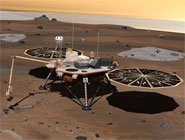Watch coverage of the landing from 25 May 2008
NASA’s Phoenix Lander is due to land on Mars this month (May) where it will probe the arctic landscape searching for conditions favourable for past or present life. UK scientists from the University of Bristol and Imperial College London have provided hardware for the mission and will be based at NASA's Arizona Science Operations Centre on landing day where they will be part of the team operating the microscope station.
After its 422 million mile journey, Phoenix is due to land on the icy northern plains of Mars at 00:53 BST on the 26th May. In the seven final minutes of its almost ten month flight, Phoenix must perform a challenging series of actions to slow down from nearly 13,000 mph to about 5 mph. It will release a parachute and use pulse thrusters to slow, before it lands on three legs.
Once safely landed, Phoenix will be ready to start its search for ice beneath the Martian surface. It will have three months to undertake its prime work and possibly five months before the Martian autumn sets in and the solar panels can no longer power operations.
One objective of Phoenix is to monitor the polar weather and the interaction of the atmosphere with the surface. The polar atmosphere during summer is a quite different environment compared to that visited by previous landers. During the northern summer it’s believed that water vapour is driven off ice at Mars’ north polar cap and enters the atmosphere.
David Catling from the University of Bristol and science team co-investigator on the mission to study this relationship said, “The landing phase will be one the most exciting and tense parts of this mission, with so much riding on Phoenix’s safe descent. Everyone involved is on tenterhooks and eager to start this unique exploration.”
Professor Keith Mason, Chief Executive of the Science and Technology Facilities Council (STFC), who support the UK involvement in the mission said, “Even though there is already a great deal of research and reconnaissance on Mars, we are still only at the beginning of our journey to understand our sister planet. This mission is especially exciting as it uses new and unique tools and not only will it help us find out more about this fascinating planet, but may take us forward in our search for alien life.”
Supported by grant funding from STFC, the Phoenix team at Imperial College London have provided micro-machined silicon substrates which provide a surface on which to hold the dust and soil samples for analysis in the microscope station attached to the Lander. The grains of Martian dust and soil, delivered by a mechanical excavation arm, will be imaged by an optical microscope and an atomic force microscope. Together they will provide the highest resolution of imaging ever taken on another planet.
Dr Tom Pike, who heads up the UK Phoenix team for Imperial College London, said, “This is a very exciting mission which provides us with the first chance to reach and analyse Martian water, frozen and stored just beneath Mars’ surface. Our sophisticated tools will allow us to look at the highest level of detail, both with imaging and chemical analysis, of any mission to date. This should give us the clearest indication so far as to whether Mars could have hosted life at any point in its history.”


